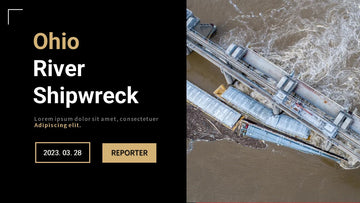What will be the impact of the sinking of a US barge carrying 1,400 tons of toxic chemicals in the Ohio River?
par HeJiang Peng sur Mar 29, 2023
According to the National Broadcasting Corporation (NBC), the Louisville City Emergency Management Agency stated in a statement on the 28th that the accident occurred at about 2 a.m. that day when a tugboat connected to 11 barges collided at the entrance of the Portland Canal. 10 barges were separated from tugboats, three barges were trapped at McAlpine Dam, and one barge carrying 1,400 tons of methanol was partially submerged.
Except for one barge carrying methanol, the other barges were loaded with soybeans and corn, the statement said. Several emergency response teams have been deployed to the Ohio River, and traffic control has been implemented near the dam. The U.S. Army Corps of Engineers (USACE) said that as of the afternoon of the 28th, another seven out-of-control barges had been transferred, and there were no reports of missing persons or casualtie

The Kentucky Department of Energy and Environment (EEC) said state and federal agencies were planning to remove three barges that were stuck at the dam. There is currently no evidence that the (methanol) storage tanks have ruptured or caused any leaks, and air and water testing agencies are in place. If a spill does occur, the EEC predicts that the methanol should be quickly diluted by the river, but some fish may die.
Louisville Water Company urges people not to worry too much about water pollution. The company stated that the incident occurred downstream of the water intake, so the safety of drinking water in the city will not be affected, and "people's water is safe to drink."
Methanol is a highly toxic, highly flammable alcohol compound commonly used in products such as antifreeze and carburetor cleaners. The U.S. federal health agency classifies formaldehyde as "toxic alcohol" and is "extremely dangerous" to the human body. Once ingested, it will cause serious consequences such as coma, respiratory failure and even death. Additionally, formaldehyde vapors that accumulate in confined spaces present a risk of explosion if ignited. Another "drug shipwreck" in the United States: a barge carrying 1,400 tons of methanol sank in the Ohio River
VORMOR CLASS
1. What are the hazards of methanol?

Methanol is a highly flammable and volatile liquid that can be ignited by heating, sparks or open flames, resulting in a fire; its vapor can form an explosive mixture with air and cause an explosion. The explosion limit is 6.0% to 36.5% (volume).
Methanol can cause systemic diseases to the human body, mainly including central nervous system damage, eye damage and metabolic acidosis. Nervous system symptoms mainly include: dizziness, headache, vertigo, fatigue, staggering gait, insomnia, indifferent expression, cloudy consciousness, etc.; Eye symptoms mainly include: initially manifested as dark shadows in front of the eyes, flashing sensation, blurred vision, eyeball pain, photophobia, diplopia, etc.; in severe cases, the vision will drop sharply, which may cause persistent blindness in both eyes. The manifestations of metabolic acidosis are: cyanosis and rapid breathing in severe cases.
2. During the accident handling process, what protective measures should be implemented at the scene?
1. In terms of public safety,
first call the emergency number listed on the shipping label, or your local fire emergency number. Take emergency preventive measures, do a good job of on-site evacuation, evacuate irrelevant personnel, and stay in the upwind direction, and do not enter low-lying areas. An isolation distance should be set around the leakage area. If only leakage occurs, the isolation distance should be at least 50 meters; if a fire occurs and there are storage tanks, tank trucks, and tank trucks on site, the isolation distance should be at least 800 meters.
2. In the event of fire in storage tanks or trucks,
extinguish the fire as far away as possible or use remote-controlled water guns and water cannons; cool containers containing dangerous substances with plenty of tap water until the fire is completely extinguished. If the safety valve of the container sounds or the tank discolors, evacuate quickly and stay away from the tank engulfed by the fire. For violently burning fires, use remote-controlled water guns or water cannons to extinguish the fire from a distance, otherwise, evacuate from the fire and let it burn.
3. In the event of a spill or leak,
rescuers should wear fully enclosed vapor protective clothing to deal with the spill or leak without fire; eliminate all fire sources, and the equipment used must be grounded; do not touch or pass through the leak, and on the premise of ensuring safety, Stop the leak. Prevent the leakage from entering drains, sewers, etc.; and set up dikes in front of the leakage of liquid, waiting for treatment.
4. first aid for the injured
4.1 Quickly leave the scene
After the incident, all personnel in the leakage area should be quickly transferred to a safe area upwind of the leakage. Call 120 or other emergency medical service centers, and the medical personnel should quickly classify the patients according to their conditions and make corresponding signs to ensure that the medical personnel can treat the critically injured; at the same time, they should strengthen the observation of the general wounded and give necessary inspections regularly and treatment, so as not to delay the timing of treatment. When medical personnel conduct on-site treatment, they should wear appropriate personal protective equipment according to the actual situation. Work on site must be strictly in accordance with the division of areas, and do not go to the leakage area.
4.2 Prevent the poison from continuing to be absorbed
Take off the contaminated clothes (including underwear), shoes and socks, and gloves immediately, rinse with plenty of running water, and pay attention to cleaning the contaminated hair at the same time. Avoid washing with hot water. For those who splash methanol into the eyes, they should be washed in time and fully. For places where there is no clean water source, they can also be washed with tap water, and the washing time should not be less than 20 minutes; patients who have inhaled poisoning should be sent to fresh air immediately, rest quietly, and maintain the respiratory tract. Unobstructed and given oxygen if necessary.
4.3 Cardiopulmonary resuscitation
After the patient is rescued from the leakage site, if the heart or breathing stops, cardiopulmonary resuscitation should be performed immediately.
4.4 Treatment of patients with loss of consciousness For
patients with loss of consciousness, attention should be paid to changes in pupils, respiration, pulse and blood pressure, and foreign bodies in the mouth should be removed in time. When convulsions occur, diazepam or phenobarbital antispasmodics should be used in time. After initial rescue at the scene, the patient was transferred to a nearby hospital for further treatment under the close monitoring of medical staff.
Now we use VORMOR X5 Pro Dictionary Pen to learn the word explanation of methanol







